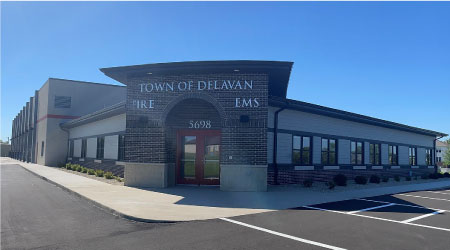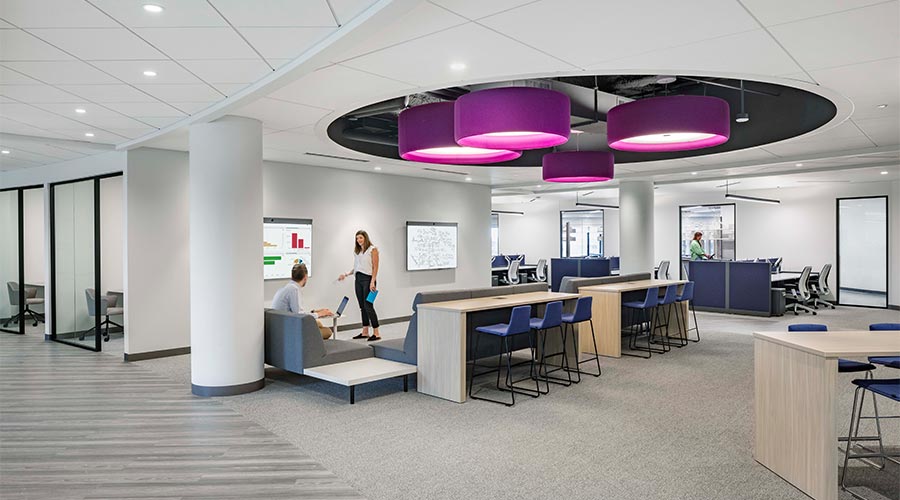What’s Old is New Again: Redefining a Small-Town Fire Station
A new fire station in Wisconsin includes several smart building features that help contribute to the facility's energy efficiency and sophistication.
After 45 years of meeting the fire and rescue needs of Delavan, a small town in southeastern Wisconsin, the town’s firehouse was simply beyond repair and was recently replaced with a new building teeming with modern construction and high-tech amenities to meet the growing needs of the community.
As the town’s hub for fire rescue and lifesaving services, the new 25,000-square-foot facility now boasts a fire pump room, EMS storage space, eight bays, offices, a kitchen and conference rooms. After a series of budget constraints that lacked approval from local voters, Scherrer Construction Company, a Wisconsin general contractor, worked with the Town of Delavan Administrator to develop a $2.5 million budget that would keep the costs down, while providing the town with a much-needed new fire station. Built on the same spot as the original building, the streamlined, yet state-of-the-art building design allows for streamlined efficiencies and ample space for this fire-and-rescue team to serve the Delavan community.
“The key goal of this project was to construct a larger, more modern fire station so the Town of Delavan could consolidate and close one of the other less-used fire stations,” says Mark Kuzniewski, senior project manager at Scherrer Construction.
“Another goal was to provide a new fire station that meets the needs of the growing staff and community in the Town of Delavan,” Kuzniewski says. “The previous station was too small and outdated. It was built in 1973 and was in deteriorating condition. There also wasn’t enough space for equipment storage, fire trucks, rescue vehicles or the growing staff in the Town of Delavan.”
There were several key goals to this firehouse project. The first one was to build a new fire station that was more energy- and space-efficient. The new Town of Delavan fire station building has several unique features that serves that goal, including heated floors, a computer-automated HVAC system, and energy-saving electrical features such as LED lighting and sensor lighting. There were no “smart design” aspects incorporated into the design.
In addition, as the needs of the Town of Delavan have grown over the years, the fire-and-rescue department needed more space.
“So, we included extra sleeping quarters as they added more full-time staff to the Town of Delavan fire and rescue team,” Kuzniewski says.
The construction team also provided a seamless transition from the old building to the new building, decreasing the number of disruptions to operations and the staff. Lastly, they tore down the old fire station upon completion of the new one.
“Scherrer Construction helped guide us through the construction management of our new fire station to help design a facility that will be used by generations of future fire department members,” says John Olson, administrator, Town of Delavan. “We have also received public compliments on the aesthetics and ‘curb appeal’ to our new building.”
Olson and the fire chief were heavily involved with the project from start to completion and they were the construction team’s main contacts for adjustments and changes to the scope of work.
“We were in constant communication with the project manager and on-site superintendent on a weekly basis and would update the Town of Delavan and fire department through monthly board meetings to address any changes or updates,” Olson says.
Thanks to the solid HVAC design, the new fire station building is much more modern and energy efficient. The mechanics are all automated to save on energy and costs. For example, the lights go on during occupied times and the same thing happens with the HVAC system throughout the building.
“These systems are all run by a computer so there are no thermostats,” Olson says.
Embracing challenges
As with any project involving a public service building such as a firehouse or police station, ensuring the construction disrupted the daily movements of the emergency services was paramount. The entire construction team’s goal was to not hinder the ongoing functions of the pre-existing firehouse.
Another big challenge faced by the construction team while working on this project was coordinating and planning for proper site utilities, such as storm, sewer, electrical and gas of the new fire station building while the old fire station was still in use. As Kuzniewski explains, the new station was constructed next to the old one, so it took detailed planning in the beginning stages to make sure the Town of Delavan fire station could still operate as needed, respond to emergency calls and get their trucks and equipment out in a fast, safe and timely manner.
“An additional challenge was a six-week delay on materials and labor due to COVID-19. Despite this, Scherrer Construction completed the project within budget and on schedule,” Kuzniewski says.
One of the most significant changes in the new Town of Delavan fire station versus the old fire station is its size. The new fire station allows the firefighters to keep their equipment in one place instead of sending people to two locations for equipment.
Olson says another key challenge was complying with the stormwater management plan and erosion control as there were some issues for the first few months.
“However, we resolved them and got right back on track with our schedule,” Olson says. “The new fire station is a state-of-the-art facility and was built for now and the future.”
Additionally, a large part of the success of this project was due to the strong communication between the owner, architect and construction team.
“The three of us were in constant communication with key decision-makers, including the town administrator, town chief and assistant, who were all involved throughout the project,” Kuzniewski says. “This made the job run smoothly and seamlessly throughout any challenges we faced.”
Maura Keller is a freelance writer based in Plymouth, Minnesota.
Related Topics:












